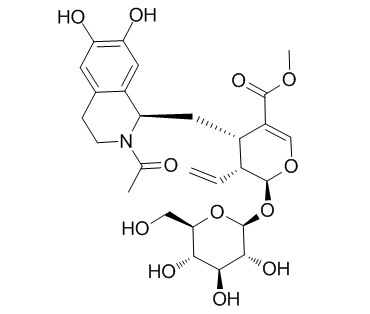Ipecoside
Reference standards.
Inquire / Order:
manager@chemfaces.com
Technical Inquiries:
service@chemfaces.com
Tel:
+86-27-84237783
Fax:
+86-27-84254680
Address:
1 Building, No. 83, CheCheng Rd., Wuhan Economic and Technological Development Zone, Wuhan, Hubei 430056, PRC
Providing storage is as stated on the product vial and the vial is kept tightly sealed, the product can be stored for up to
24 months(2-8C).
Wherever possible, you should prepare and use solutions on the same day. However, if you need to make up stock solutions in advance, we recommend that you store the solution as aliquots in tightly sealed vials at -20C. Generally, these will be useable for up to two weeks. Before use, and prior to opening the vial we recommend that you allow your product to equilibrate to room temperature for at least 1 hour.
Need more advice on solubility, usage and handling? Please email to: service@chemfaces.com
The packaging of the product may have turned upside down during transportation, resulting in the natural compounds adhering to the neck or cap of the vial. take the vial out of its packaging and gently shake to let the compounds fall to the bottom of the vial. for liquid products, centrifuge at 200-500 RPM to gather the liquid at the bottom of the vial. try to avoid loss or contamination during handling.
Toxicol Res.2019, 35(4):371-387
J Ethnopharmacol.2019, 244:112074
Sci Rep.2019, 9:19059
Journal of Apicultural Research2021, 60(1).
Heliyon.2022, e12337.
Toxicol In Vitro.2022, 81:105346.
Molecules.2023, 28(8):3414.
Proc Biol Sci.2024, 291(2015):20232578.
Food Bioscience2023, 53:102687
Research Square2021, 10.21203.
Related and Featured Products
J Biol Chem. 2008 Dec 12;283(50):34650-9.
The new beta-D-glucosidase in terpenoid-isoquinoline alkaloid biosynthesis in Psychotria ipecacuanha.[Pubmed:
18927081]
Ipecac alkaloids produced in the medicinal plant Psychotria ipecacuanha such as emetine and cephaeline possess a monoterpenoid-tetrahydroisoquinoline skeleton, which is formed by condensation of dopamine and secologanin. Deglucosylation of one of the condensed products N-deacetylisoIpecoside (1 alpha(S)-epimer) is considered to be a part of the reactions for emetine biosynthesis, whereas its 1 beta(R)-epimer N-deacetylIpecoside is converted to Ipecoside in P. ipecacuanha.
METHODS AND RESULTS:
Here, we isolated a cDNA clone Ipeglu1 encoding Ipecac alkaloid beta-D-glucosidase from P. ipecacuanha. The deduced protein showed 54 and 48% identities to raucaffricine beta-glucosidase and strictosidine beta-glucosidase, respectively. Recombinant IpeGlu1 enzyme preferentially hydrolyzed glucosidic Ipecac alkaloids except for their lactams, but showed poor or no activity toward other substrates, including terpenoid-indole alkaloid glucosides. Liquid chromatography-tandem mass spectrometry analysis of deglucosylated products of N-deacetylisoIpecoside revealed spontaneous transitions of the highly reactive aglycons, one of which was supposed to be the intermediate for emetine biosynthesis. IpeGlu1 activity was extremely poor toward 7-O-methyl and 6,7-O,O-dimethyl derivatives. However, 6-O-methyl derivatives were hydrolyzed as efficiently as non-methylated substrates, suggesting the possibility of 6-O-methylation prior to deglucosylation by IpeGlu1. In contrast to the strictosidine beta-glucosidase that stereospecifically hydrolyzes 3 alpha(S)-epimer in terpenoid-indole alkaloid biosynthesis, IpeGlu1 lacked stereospecificity for its substrates where 1 beta(R)-epimers were preferred to 1 alpha(S)-epimers, although Ipecoside (1 beta(R)) is a major alkaloidal glucoside in P. ipecacuanha, suggesting the compartmentalization of IpeGlu1 from Ipecoside.
CONCLUSIONS:
These facts have significant implications for distinct physiological roles of 1 alpha(S)- and 1 beta(R)-epimers and for the involvement of IpeGlu1 in the metabolic fate of both of them.



